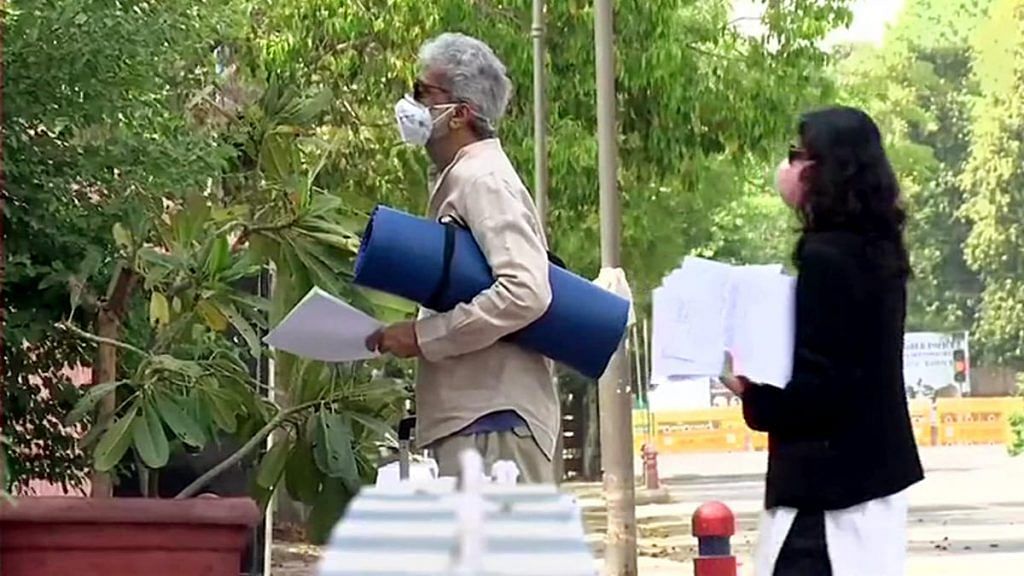New Delhi: In a supplementary chargesheet filed in the Bhima Koregaon case, the National Investigation Agency (NIA) has accused activist Gautam Navlakha for his alleged links to Pakistan’s intelligence agency Inter-Services Intelligence (ISI).
According to the NIA sources, Navlakha’s involvement came up in the “secret communications with CPI (Maoist) cadres” that he had on several occasions.
“He was assigned the task to unite intellectuals against the Government,” an NIA officer, who did not wish to be identified, said.
“He was part of some fact-finding committees and was assigned the task to recruit cadres for guerrilla activities of CPI (Maoist),” he added.
In July this year, the NIA questioned Navlakha about his alleged links with Syed Ghulam Nabi Fai, the US-based ‘Pakistan Kashmiri separatist’ who was arrested by the Federal Bureau of Investigation (FBI) in 2011, and later sentenced to a two-year term.
Navlakha was particularly asked about a claim made by US Attorney Neil H MacBride in an affidavit in 2011 on the basis of a FBI investigation that claimed the activist was introduced to an ISI General for recruitment by Fai at the agency’s direction, sources claimed.
According to sources in the NIA, Navlakha also made visits to the US on a few occasions to attend seminars on Kashmir organised by Fai’s Kashmiri American Council (KAC).
In its chargesheet, the NIA named Anand Teltumbde, Gautam Navlakha, Hany Babu, Sagar Gorkhe, Ramesh Gaichor, Jyoti Jagtap, Stan Swamy and Milind Teltumbde under sections of criminal conspiracy, sedition and the Unlawful Activities (Prevention) Act (UAPA).
Also read: NIA probe into Bhima-Koregaon being used to crackdown on dissidents, say over 1,000 academics
‘Discreet’ codes used for communication
The NIA has claimed to have recovered incriminating documents from the accused including their “discreet communications” with other Maoist cadres regarding “conspiracy related to the violent incident of Bhima Koregaon as a part of their well chalked-out strategy.”
The investigating agency also claims to have recovered documents regarding “mobilisation against the Constitutionally established Government by the Maoist cadres”, “information about movement of the security forces with an intention to cause heavy damage to the State.”
The NIA officer quoted above said that discreet codes were used for secret communication amongst themselves to avoid detection by security forces regarding their conspiracy and planning.
“Investigation also revealed a systematic network of Maoists operating for supply of arms & ammunitions having close nexus with other banned proscribed organisations within & outside India,” the officer said.
“The Strategy & Tactics adopted by Maoists to carry out so-called urban revolution with their frontal outfits has also been revealed during investigation,” the officer added. “Beside this, funding activities of Maoist cadres & their sympathisers to carry out Maoist work in rural as well urban areas came to the fore.”
The ‘conspiracy’
According to the NIA, the investigation revealed that the accused — Anand Teltumbde, Gautam Navlakha, Hany Babu, Sagar Gorkhe, Ramesh Gaichor, Jyoti Jagtap and Stan Swamy — “conspired with other accused persons to further the ideology of terrorist organisation CPI (Maoist) and abetted violence, brought into hatred & incited disaffection towards the Government”
NIA further claimed that the men “promoted enmity between different groups on grounds of religion, caste and community.”
“The absconding accused Milind Teltumbde also organised training camps for imparting weapons training to other accused persons,” the NIA officer said.
Anand Teltumbde, NIA claimed, was one of the conveners of ‘Bhima Koregaon Shaurya Din Prerna Abhiyan’ and was present at Shaniwar Wada, Pune on 31 December 2017 where the Elgar Parishad Programme was organised.
“He played an active role with other Maoist cadres and received funds from them for carrying out the activities,” the officer added.
The NIA claimed, Hany Babu — an Associate Professor at Delhi University — was instrumental in organising visits of foreign journalists to CPI (Maoist) areas and was assigned present and future task of Revolutionary Democratic Front (RDF), a banned organisation in Andhra Pradesh and Telangana.
“He was in contact with banned terrorist organisation Kanglepak Communist Party (KCP) of Manipur and was instrumental in making efforts for release of convicted accused G.N. Saibaba on the directions of CPI (Maoist) and was raising funds for the same,” the officer said.
The officer further claimed that Sagar Gorkhe, Ramesh Gaichor and Jyoti Jagtap, are trained cadres of CPI (Maoist) and members of its frontal organisation Kabir Kala Manch.
“They attended meetings for the organisation of the Elgar Parishad programme with other co-accused as a part of a well chalked out conspiracy. They propagated the agenda of CPI (Maoist) and made planning and coordination all over Maharashtra,” the officer said.
Stan Swamy, the NIA claimed, was in communication with other CPI (Maoist) cadres and propagated that the arrest of the cadres from different parts of country, particularly in Maharashtra, has caused a “huge irrevocable damage to CPI (Maoist)”
NIA alleged Swamy received funds from other Maoist cadres for the furtherance of the activities of CPI (Maoist).
Also read: Priest, activist, ‘Naxal backer’ — who’s Stan Swamy, latest NIA arrest in Bhima Koregaon case
